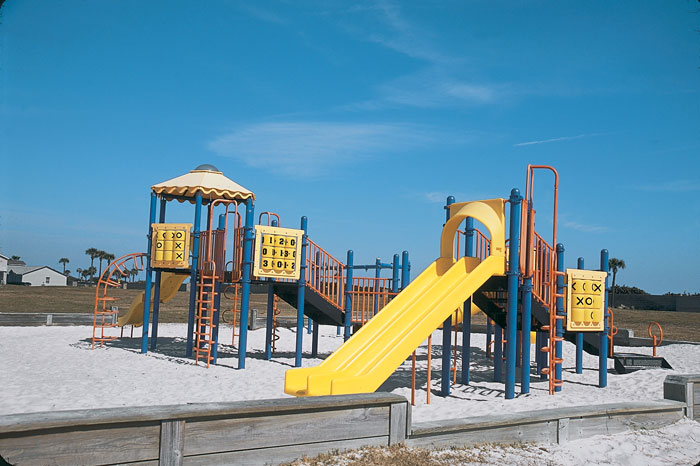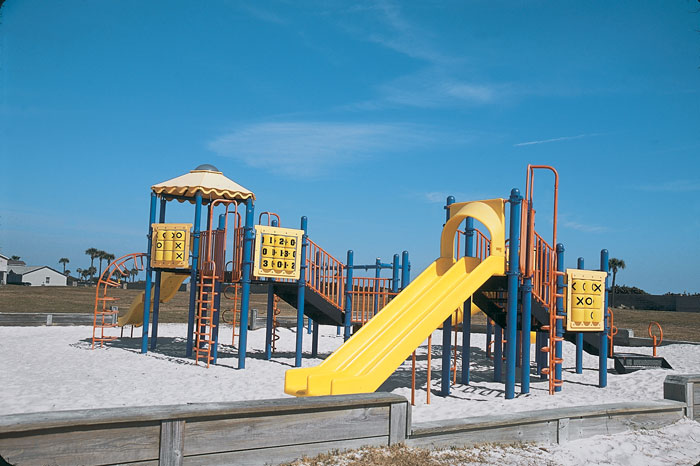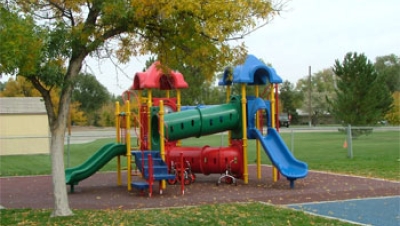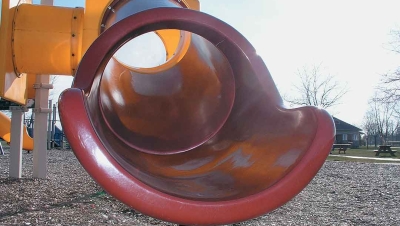You bet! Playgrounds included
People may picture life on a military base as a structured, sterile environment. Or, perhaps the shenanigans of Hawkeye Pierce or Gomer Pyle come to mind. More than likely, life on base consists of both rigid structure and hilarious antics, providing soldiers a nice balance to life in the military. But does the Department of Defense take into consideration the lives of military personnel and their families? That question can be answered with a simple “yes.” Today, more and more families call the base “home” with family-oriented activities becoming commonplace, including playgrounds.

The revamping of military bases has been a hot topic in the Congress for some time with morale and Quality of Life issues being a factor in the appropriation of funds. Better living conditions for armed forces personnel plays a large part in military retention. In his April 10, 2002, testimony before the House Armed Services Subcommittee on Military Installations and Facilities, Undersecretary of Defense for Installations and Environment Raymond J. DuBois stated, “the President and the Secretary of Defense have indicated that improving military housing is one of their top priorities. In 1997, the Department established a goal to eliminate inadequate housing by 2010. Because of the importance, he places on improving the living conditions of our military members and their families, Secretary Rumsfeld accelerated that goal to 2007.” On October 23, 2002, President Bush signed two appropriations bills funding military construction for the fiscal year 2003. According to an Engineering News Record article on October 23, 2002, “The MILCON bill provides $10.5 billion for building and upgrading military installations and for family housing units” and “within that sum, DOD housing operation, maintenance, and construction received $4.2 billion, a two percent boost. That includes $1.3 billion for construction of new family housing units and improvements to existing facilities. Another $2.9 billion will go for family housing operation and maintenance.”

Any money appropriated by Congress not only goes toward military housing but also toward youth centers, childcare centers, and playgrounds, promoting an optimal environment for children on base. Carolynn Jones, of RecWest, a representative company for Landscape Structures, says, “The children of our armed services personnel already feel more stress than the average child because their loved ones are involved in dangerous but important work. Those children need places where they can let off steam, run, jump and play—places where they can truly be children.” The new playgrounds contain the latest entertaining equipment. Newfangled pieces now take the place of rickety, tattered, rusted-out monstrosities. When designing their playgrounds, the military takes into consideration all aspects of child’s play. The Army Corps of Engineers details in their 1997 manual how to plan for child development, range of play activity, which deals with how children play in an environment, sensory variety, spatial complexity and different levels of challenge depending on age and skill. One of the most important factors civil engineers consider while patterning military base playgrounds has to do with planning for people with disabilities.
According to www.futureofchildren.org, “each military child care center has playgrounds for different age groups and space for disabled children. Safety and quality are carefully monitored.” And the Army Corps of Engineers manual states, “play area components will be accessible to children and adults with disabilities. In addition to wheelchair users, the needs of children and adults who walk with canes, walkers or crutches who have limited use of the upper body who have visual or hearing disabilities or who have developmental disabilities will be considered.”

The military considers people with disabilities when designing their playgrounds, but safety also plays an integral role in playground planning. The Army Corps of Engineers manual details the specifications for designing military playgrounds, paying special attention to playground safety issues. The manual states, “children’s outdoor play areas will meet the requirements of the CPSC Handbook for Public Playground Safety and the American Society for Testing and Materials (ASTM) Standard Consumer Safety Performance Specification for Playground Equipment for Public Use (ASTM F 1487).”
Complying with these criteria can be overwhelming for playground designers and manufacturers. To simplify this process, IPEMA, otherwise known as the International Play Equipment Manufacturer’s Association, works as an independent examiner to ensure a manufacturer’s playground equipment conforms to ASTM F1487-01, ASTM F1292 and CAN/CSA-Z614-98 standards. If the equipment meets IPEMA specifications, each playground component receives an IPEMA seal. Vandenberg Air Force Base, in California, works to comply with IPEMA standards and currently about 40 to 50 new and renovated playgrounds exist on base. Mike Bird, a Civil and Professional Engineer and a Certified Playground Safety Inspector at Vandenberg Air Force Base has been involved with the base’s housing and park development. Bird received his Certification as a Playground Safety Inspector from NPSI in 2000. He says safety figures prominently in the design of playgrounds at Vandenberg and the new playgrounds meet IPEMA safety requirements. Vandenberg renovates or replaces any older equipment that does not comply with IPEMA’s standards.

Landscape Structures, a manufacturer whose products satisfy IPEMA’s criteria, furnished some of Vandenberg’s playground equipment. Carolynn Jones says of Bird, “Mike was concerned about safety issues so he had a safety audit done so he could address any potential problems. On the existing Landscape Structures play equipment, we provided new pieces to bring the existing structures into compliance with the new safety standards.”
Bird wants to form a maintenance contract minded by someone in the Quality Assurance department to ensure playground safety. The contract would stipulate that a Certified Playground Safety Inspector would be in charge of overseeing the maintenance of playgrounds thereby making it easier to monitor the safety standards of the children’s play centers. Jones says, “Mike also wants to increase the maintenance in playgrounds so more preventative measures can be taken. He has a very proactive approach to his playgrounds and wants to increase the normal maintenance schedule so average maintenance issues won’t become safety concerns.”
The military concerns itself with their soldiers on the battlefield, as well as the families living on base.




















Add new comment